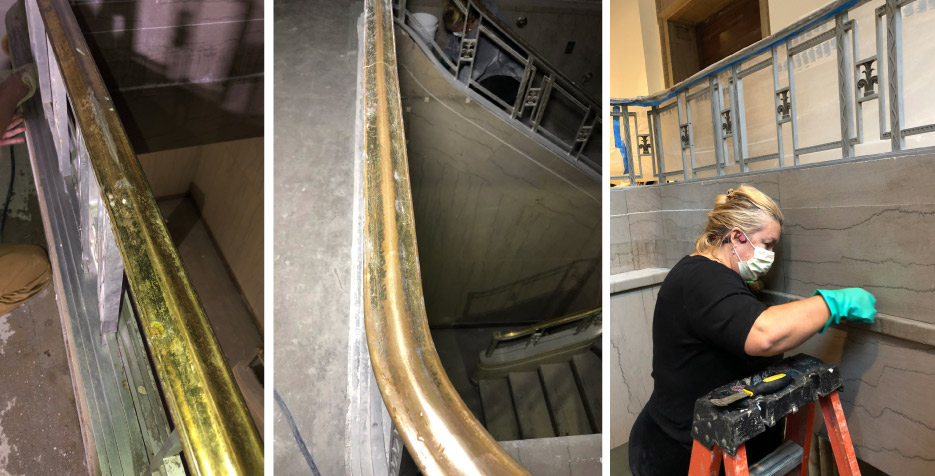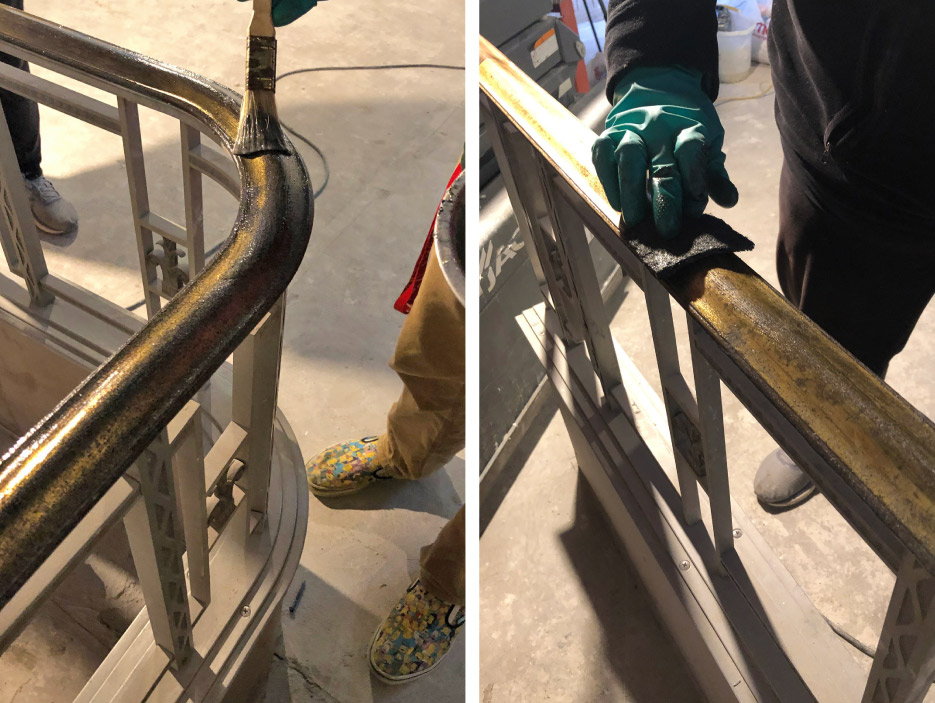Stone Restoration and Maintenance Corner: Restoring Marble & Metal?
Bob Murrell
M3 Technologies
Photos by Bob Murrell
If you read my December 2020 article “Working for the General Contractor,” regarding the Holston Building restoration (Vida and The Vault) in downtown Knoxville, Tennessee, the handrails of the staircase are made of aluminum with solid brass on top. Now I know quite a few of my M3 Technologies customers who do metal along with marble and other hard surfaces. Why, I even did a previous article, a couple of years ago, about restoring Corian. Writing about metal, however, was something I hadn’t attempted in quite a long time.
In fact, the last time I personally worked on brass was when I was in the Navy, during 1978-1982. That has definitely been a few years ago!
Now, in the Navy, there are plenty of brass railings, trim, and fittings that need maintenance and fortunately, there are plenty of sailors around to do the work, too. So they gave us a product called Never Dull Magic Wadding. It worked great, as long as you polished with it routinely, as brass will tarnish rather quickly. There is a type of oil product in the Never Dull which offers some temporary protection, but doesn’t last for very long, especially when being continuously touched by sweaty hands.
When the testing came about on the brass handrail, I remembered the Never Dull and it was tried first. There was a black tarnish and something more on the handrail which the Never Dull just wouldn’t cut through, at least not at an acceptable productivity rate for me. So we tried Brasso liquid polish next. It performed about the same as the Never Dull. Pretty much anywhere there was no black stuff and what looked like brass colored paint, it shined the metal up really good, just like back in the good ol’ Navy days.
At this point, I reached out to one of my customers, who offers metal restoration as part of their routine service, and asked them for guidance. I explained the issue and sent some pictures via IPhone and he confirmed that there was indeed a coating on the handrail. Therefore, the old coating, which was probably an enamel or a lacquer, had to be stripped first. A test was done and it was determined that a safety stripper (non-methylene chloride) in combination with a Scotch-Brite type scrubbing pad did the job well.
 |
|
Above, left: Cleaning the aluminum balustrade and brass handrail. Above, middle: This closeup shows the damaged coating, probably a lacquer, on the brass handrail. Above, right: Julie cleaning the marble stair encasement and walls. Removing the old residues from tobacco smoke revealed the hidden beauty of the Tennessee Pink walls. |
The stripper was applied with a paint brush (not a Purdy!) and allowed to dwell long enough to cut the old lacquer. Then the scrub pad was used to actually remove the coating and any other residues. This process had to be repeated several times to get down to the bare brass.
Once all of the existing coating was properly removed, any scratches or tarnish had to be removed by sanding with 200 grit and finally 400 grit sandpaper. The brass was then rubbed down with the scrubbing pad again to blend, and help make everything look consistent. Note: always rub with the length of the brass (it’s not really a grain thing) to help avoid the look of a cross pattern, which will stick out like a sore thumb.
When the brass is free from coatings and well sanded to a medium to medium-high gloss, it will start to tarnish, if not coated with an oil based product like Brasso, or sprayed with a clear lacquer or enamel. If you choose to use a Brasso or Never Dull type product, as mentioned before, you will have to maintain with this product routinely. However, if you use a clear lacquer, it should keep the brass looking great and last for many years.
Another issue with the metal on this project, and for that matter all of the existing surfaces, was residues left behind from many years of being subjected to cigarette smoke. Remember this building was opened in 1913, when smoking was a common and accepted practice indoors.
There are lots of toxic chemicals in tobacco-related residue such as nicotine, cotinine, and a potent lung carcinogen called NNK or Nicotine-derived nitrosamine ketone (say that one three times fast).
Majestic Deep Cleaner Degreaser was prescribed, in combination with a non-abrasive scrub pad, to clean all of the vertical marble and aluminum surfaces. Of course, there was also plenty of elbow grease required, as well.
Normal aluminum cleaners are acidic, so this was not really an option as most all of the surrounding surfaces were, of course, marble. This entailed some very careful cleaning, and paying attention to adjacent surfaces.
 |
|
Above, left: Applying paint stripper to facilitate removal of old lacquer from the brass handrail. Above, right: A common scrub pad was used to remove the loosened old lacquer and clean the brass handrail. A sealer was applied over the restored brass. |
As mentioned in the last article (December 2020), this is a large commercial project and is still going on as I type. It won’t be completed for another 30 days at least. Knoxville Marble Polish is working when they can, as permitted, and will hopefully have their aspect of the project completed soon.
As soon as I get the photos and final results from both the Vida and The Vault project as well as the Candoro Office building project, I will submit a final results article of both completed projects. Hopefully, it will be worth the wait.
I sure hope that everyone had a safe and Happy Holiday Season. I also hope for a much better 2021 for all.
As always, I recommend submitting a test area to confirm both the results and the procedure prior to starting a stone or hard surface restoration or maintenance project. Also the best way to help ensure success is by partnering with a good distributor, like Braxton Bragg, that knows the business. They can help with technical support, product purchase decisions, logistics, and other pertinent project information.
I pray you all stay safe and healthy.
Bob Murrell has worked in the natural stone industry for over 40 years and is well known for his expertise in natural stone, tile and decorative concrete restoration and maintenance. He helped develop some of the main products and processes which revolutionized the industry, and is currently the Director of Operations for M3 Technologies.